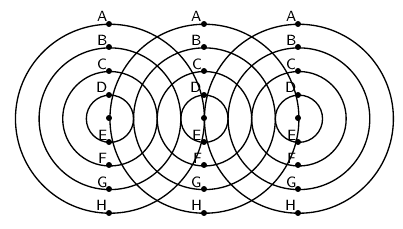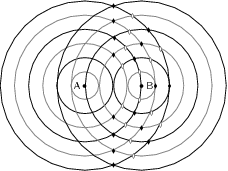| << Chapter < Page | Chapter >> Page > |
You have learnt about the basic principles of reflection and refraction. In this chapter, you will learn about phenomena that arise with waves in two and three dimensions: interference and diffraction.
The diagram shows three identical waves being emitted by three point sources. All points marked with the same letter are in phase. Join all points with the same letter.

What type of lines (straight, curved, etc) do you get? How does this compare to the line that joins the sources?
Consider three point sources of waves. If each source emits waves isotropically (i.e. the same in all directions) we will get the situation shown in as shown in [link] .

We define a wavefront as the imaginary line that joins waves that are in phase. These are indicated by the grey, vertical lines in [link] . The points that are in phase can be peaks, troughs or anything in between, it doesn't matter which points you choose as long as they are in phase.
Christiaan Huygens described how to determine the path of waves through a medium.
Each point on a wavefront acts like a point source of circular waves. The waves emitted from these point sources interfere to form another wavefront.
A simple example of the Huygens Principle is to consider the single wavefront in [link] .

Given the wavefront,

use the Huygens Principle to determine the wavefront at a later time.


Huygens generally receives minor credit for his role in the development of modern calculus. He also achieved note for his arguments that light consisted of waves; see: wave-particle duality in Chapter [link] . In 1655, he discovered Saturn's moon Titan. He also examined Saturn's planetary rings, and in 1656 he discovered that those rings consisted of rocks. In the same year he observed and sketched the Orion Nebula. He also discovered several interstellar nebulae and some double stars.
Interference occurs when two identical waves pass through the same region of space at the same time resulting in a superposition of waves. There are two types of interference which is of interest: constructive interference and destructive interference.
Constructive interference occurs when both waves have a displacement in the same direction, while destructive interference occurs when one wave has a displacement in the opposite direction to the other, thereby resulting in a cancellation. When two waves interfere destructively, the resultant absolute displacement of the medium is less than in either of the individual displacements. When total destructive interference occurs, there is no displacement of the medium. For constructive interference the displacement of the medium is greater than the individual displacements.
Constructive interference is the result of two waves with similar phase overlapping. This means that positive parts of one wave tend to overlap with positive parts of the other, and alike for the negative parts. When positive is added to positive and negative is added to negative, the net absolute displacement of the medium is greater than the displacements of the individual waves.
Destructive interference, on the other hand, is the result of two waves with non-similar phase (i.e. anti-phase) overlapping. This means that the positive parts of one wave tend to align with the negative parts of the second wave. When the waves are added together, the positive and negative contributions lead to a net absolute displacement of the medium which is less than the absolute displacements of either of the individual waves. A place where destructive interference takes place is called a node.
Waves can interfere at places where there is never a trough and trough or peak and peak or trough and peak at the same time. At these places the waves will add together and the resultant displacement will be the sum of the two waves but they won't be points of maximum interference.
Consider the two identical waves shown in the picture below. The wavefronts of the peaks are shown as black lines while the wavefronts of the troughs are shown as grey lines. You can see that the black lines cross other black lines in many places. This means two peaks are in the same place at the same time so we will have constructive interference where the two peaks add together to form a bigger peak.

Two points sources (A and B) radiate identical waves. The wavefronts of the peaks (black lines) and troughs (grey lines) are shown. Constructive interference occurs where two black lines intersect or where two gray lines intersect. Destructive interference occurs where a black line intersects with a grey line.
When the grey lines cross other grey lines there are two troughs in the same place at the same time so we will have constructive interference where the two troughs add together to form a bigger trough.
In the case where a grey line crosses a black line we are seeing a trough and peak at the same time. These will cancel each other out and the medium will have no displacement at that point.
On half the picture below, we have marked the constructive interference with a solid black diamond and the destructive interference with a hollow diamond.

To see if you understand it, cover up the half we have marked with diamonds and try to work out which points are constructive and destructive on the other half of the picture. The two halves are mirror images of each other so you can check yourself.

Notification Switch
Would you like to follow the 'Siyavula textbooks: grade 12 physical science' conversation and receive update notifications?